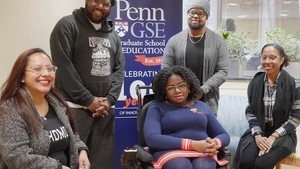Dear parents, grandparents, godparents, guardians, aunts, uncles, and adults in general:
Don't read this one. Or read it, but then forward it to the tweens and teens in your life. It’s for them.
For this edition, we've enlisted the help of five of Penn GSE doctoral students who are leading our campus’s work on the Black Lives Matter at School’s Week of Action. We asked what Black history they wished they been taught in middle and high school. As you'll see, the stories Janay Garrett, Daris McInnis, Christopher R. Rogers, Laronnda Thompson, and Latricia Whitfield shared aren't the typical Black History Month curriculum.
Instead, their ideas illustrate how students from all backgrounds can take action to make the world a more just place.
Look beyond the usual luminaries
When we were in school, many of our Black History Month lessons focused on luminaries like MLK and Rosa Parks. We bet yours do too. While we can all learn from King and Parks, the power of ordinary people working to make change shouldn’t be forgotten.
Let’s start with the tireless work of Black educator Carter G. Woodson, who began Negro History Week in 1926 with the purpose of celebrating what Black students should be learning all year through a special showcase week “spotlighting the countless Black men and women who had contributed to the advance of human civilization.” Woodson’s week grew to become Black History Month.
Woodson helped to launch the Association for the Study of African-American Life and History, which for more than 100 years has helped educators promote, research, preserve, interpret, and disseminate information about Black life, history, and culture. Woodson’s vision was never about just one week or month, but rather was an expansive vision of how teaching a people’s history can influence global movements for justice.
Put knowledge into action
In 1964, activists from the Student Nonviolent Coordinating Committee (SNCC) organized Freedom Summer with a curriculum designed to encourage “young Negro Mississippians...to articulate their own desires, demands, and questions” by centering discussions of “Negro history,” “the history of the movement,” and “the perspective of being in a long line of protest and pressure for social and economic justice.”
SNCC leaders saw that public schools in Mississippi were “geared to squash intellectual curiosity and different thinking” of Black students. As part of its larger efforts in Mississippi that included registering voters, SNCC opened Freedom Schools. The curriculum “was designed to help students examine their personal experiences with racial discrimination and understand their broader context in Mississippi’s closed society.”
SNCC’s digital archive is filled with examples of how young people worked together to challenge racist political, economic, and social structures. Go explore!
Look what happens when teens take the lead
We often tell the history of the American civil rights movement with stories set in the Jim Crow South. But Southern states didn’t have a monopoly on racism.
In 1967, Black high school students in Philadelphia decided to push back.
With chants of “Black Power!” and “Black Studies!” thousands of Philadelphia high schoolers led one of the country’s largest protest actions ever organized by teenagers. The students demanded better conditions in schools, the hiring of more African American administrators, and the inclusion of African American history in the curriculum.
The student’s peaceful march was met with a violent police reaction. But their walkout set the foundation for a decades-long struggle that eventually pushed the School District of Philadelphia to become one of the few in the U.S. that mandate African American History as a high school graduation requirement.
Make a difference by asking tough questions and becoming active in the struggle
Why are we telling you all this? Because you can make a difference!
Speak up! Don’t be afraid to ask questions. It’s important to ask, “What’s the other side of the story? What other factors may have influenced these events?” Teachers who enjoy and are committed to their work invite questions from young people.
Get active! Visit spaces of historical resistance in your community. These might be as formal as museums, landmarks, and places of faith, yet stretch to include informal spaces like independent bookstores, public squares, parks, and street corners. Where have people fought for their rights within the community you live? How did they organize people to gather together under a shared cause?

Penn GSE doctoral students Janay Garrett, Daris McInnis, Christopher R. Rogers, Laronnda Thompson, and Latricia Whitfield, who are all active in the Black Lives Matter at School Week of Action, share the Black history they wish they learned in school.
Subscribe to the Educator's Playbook
Get the latest release of the Educator's Playbook delivered straight to your inbox.
Media Inquiries
Penn GSE Communications is here to help reporters connect with the education experts they need.
